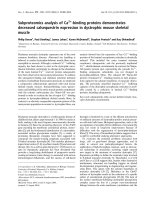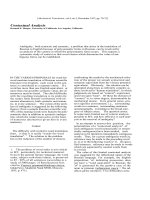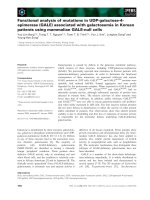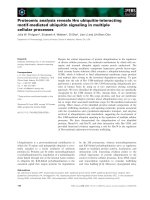Báo cáo khoa học: " Contextual Analysis in Word-for-word MT" pot
Bạn đang xem bản rút gọn của tài liệu. Xem và tải ngay bản đầy đủ của tài liệu tại đây (95.22 KB, 2 trang )
[
Mechanical Translation
, vol.3, no.2, November 1956; pp. 40-41]
Contextual Analysis in Word-for-word MT
Kenneth E. Harper, Slavic Department, University of California, Los Angeles
EXPERIMENTS with word-for-word MT of
Russian scientific literature have given results
which, except for such limited purposes as in-
dexing, are far from satisfactory. The diffi-
culty is not so much one of word order as of
syntactic and semantic ambiguity of individual
words. Regardless of the treatment of the pro-
blem of inflected forms, for example, it is im-
possible in the majority of instances to identify
the grammatical case of Russian nouns. In
addition to syntactic ambiguity, multiple equi-
valents must be assigned to a large percentage
of words (to an estimated 45% of the running
words in a physics text). The chief disadvantage
of word-for-word MT, then, is its prolixity: the
reader is confronted with a burdensome multi-
plicity of potential equivalents (syntactic and
semantic) for several words in each sentence.
The chief cause of this ambiguity is the fact
that each word is examined in isolation, as a
discrete item. The human translator operates
with the tremendous advantage of something
called "context". Broadly speaking, context
signifies environment: surrounding words, sen-
tences, and even the subject area itself. Investi-
gation shows that restricted contextual analysis,
performed routinely, can resolve most of the
problems of ambiguity. Remarkable clarifica-
tion is attained even when the comparison of a
given ambiguous word x is limited to the imme-
diately contiguous word in the sentence (the
pre-x or post-x word). Without attempting to
rearrange the word order of the Russian sen-
tence, one can obtain the following by compari-
son of each ambiguous word with the coded
grammatical features or semantic class of con-
tiguous words:
a) Syntactic clarification. The ambiguity of
case forms in nouns can be reduced to an insig-
nificant percentage, and proper English equiva-
lents can be supplied in the form of English pre-
positions as demanded by the genitive, dative,
and instrumental cases. Such prepositions can
be withheld in translation when the requirements
of Russian grammar demand it. Participles
and adverbs which are indistinguishable in form
from adjectives, can, be given the correct equi-
valent; the comparative degree of adjectives
and adverbs can be adequately handled. In
general, there are no serious problems of syn-
tax which cannot be resolved by reference to the
grammatical features of pre- or post-words.
b) Semantic clarification. The correct
English equivalents of most of the "glue words"
(especially prepositions and conjunctions) can
be found only through contextual analysis. The
programming of such analysis should be based
on the observed behavior of these words in ac-
tual conditions. Thus, the meaning of the con-
junction "i", which has at least four equivalents
(and, but, also, even) can be pinpointed in more
than 90% of all occurrences by simple reference
to the grammatical category of contiguous words;
the pronoun-adjective "ikh", meaning "(of) their"
or "(of) them", can be similarly resolved. It
should be stressed that completely unpredict-
able and unexpected relationships can be found
between structural context and meaning, and
that the barest kind of routine comparison re-
sults in a high (although not absolute) degree of
accuracy in the determination of meaning.
Non-structural clarification of meaning takes
several forms. In the first place, techniques of
MT lexicography need to be developed, i.e., the
science of choosing the best "cover-all" target
language equivalent from a group of relatively
synonymous equivalents, and the selection of
equivalents based on observed behavior, rather
than upon the evidence of a dictionary. (Thus,
in the area of physics the Russian izmenenie
may always be found to equate with "change",
although Bray's technical dictionary lists nine
fairly distinct meanings.) In effect, what is
needed are true ideoglossaries, based on actual,
rather than potential, behavior.
The application of contextual analysis offers
great potentialities for semantic clarification.
Operating again on the basis of observation, we
can construct and code word classes which
cause contiguous words to behave in a predict-
able manner. Thus, the preposition po has ten
potential possible equivalents when followed by
a noun in the dative case; by reference to pre-
determined noun classes we can reduce the
number of choices to one in a given instance.
The necessity of treating each new combination
as an "idiom" is eliminated. It is also possible
Contextual Analysis 41
to pinpoint the meaning of many nouns which
are ambiguous even within an ideoglossary by
reference to the class of the accompanying
adjective, or to specified key words in the title
or opening sentences of the text.
There is no question that the kind of study in
syntax and semantics which can be realized
with the aid of machine techniques will result
in the discovery of usable principles of associ-
ation, so vital in the operation of what is called
"contextual analysis".









